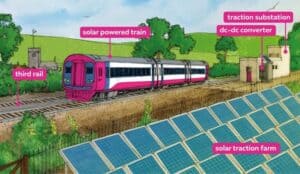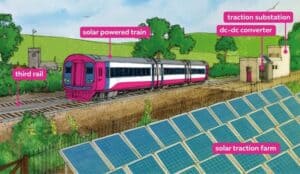Can railways be fully solar-powered?
 16 Januari 2021
16 Januari 2021
Trains are the most efficient mode of transportation we have. Despite carrying 9% of global passengers and 7% of global cargo, they make up just 3% of global transportation energy use.
Around the world, about 75% of trains are electrified with the rest running on diesel. This makes them the right candidate to run on complete clean energy without significant investments in overhauling the infrastructure.
But what would it take to do that?
In 2017, Australia ran the world’s first 100% solar-powered train fitted with a 6.5kW system on top of its two coaches. The battery capacity, at 77 kWh, was similar to a high-end Tesla Model 3 and could allow the train 6–7 round trips on its 3 km track. There is also a 30kW solar system at the station to charge the battery.
However, the train had quite some metrics to reach. Built with an investment of ~6 million AUD, the train needs 350 round trips a day to remain viable. But given the limited schedule between the daylight hours, this is a stretch. India has also had rooftop solar trains, but only to power lights and the likes within the train.
Therefore, it is still a distant reality to have 100% of rooftop solar-powered trains for the masses.

In 2019, the United Kingdom launched the world’s first railway line powered by a 30kW solar farm. Built close to the station, the farm would feed directly into the station. With its capacity, solar will directly power signaling and lights.
However, given the trains in UK use 4,050 million kWh of electricity each year, it looks unlikely that solar farms will 100% supply the power needed to run the full system in near future.
On the other hand, some countries are making much bigger attempts. The Indian government has committed to making railways carbon neutral by 2030 by building 20 GW worth of solar farms. Land close to railways has been identified, and this solar would feed directly into the railway substations and the grid. Argentina will also soon kickstart a similar effort to power a 300km train line by using a mix of rooftop panels and solar farms.
Another method of achieving this state would be through electric trains powered by batteries charged through solar, either onsite or offsite. But if we can infuse enough solar into the grid that then powers trains, I don’t see why we should go for this option as batteries have issues of their own.
Hydrogen-powered trains
In 2018, Germany launched a hydrogen-powered commercial train that can run 600 miles on a single tank. The same train is being tested now in Austria and the Netherlands.
The train being run on clean fuel has one problem though. The hydrogen itself is currently produced by fossil fuel, and this kind of negates its touted environmental benefits. This is where solar can be used to produce green hydrogen to make the whole system carbon-free.
Here countries will have two options — to electrify railways and power through renewable, or, to retrofit existing trains with batteries. And the right answer will be different for each nation. If the infrastructure is largely electrified then it makes sense to just switch the power source, but if not, then retrofitting existing trains might be an alternative and lower investment.
Other than trains and equipment, solar is successfully powering railway stations, like Antwerp Central Station and India Guwahati station, but this is akin to powering any commercial facility. When we talk of railways, we specifically talk about trains.
In a nutshell, solar powered railways can become a reality. But a solar system more than being useful to power trains directly will be more useful in the grid mix when it comes to decarbonizing trains.
The post Can railways be fully solar-powered? appeared first on Sustainability Times.
